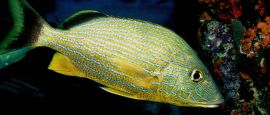The arrival of new agricultural technology made many of Bonaire’s donkeys redundant. Cue the Bonaire Donkey Sanctuary, a not-for-profit organisation set up to take care of mules that have long since retired from working on the salt pans. Visitors are encouraged to feed and help care for the ageing animals.
Bonaire things to see and do
Tourist offices
Address: Basis Communicatie BV, Wagenweg 252, Al-Haarlem, The Netherlands
Tel: (23) 543 0705.
www.infobonaire.com
Address: Basis Communicatie BV, Wagenweg 252, Al-Haarlem, The Netherlands
Tel: (23) 543 0705.
www.tourismbonaire.com
Address: Adams Unlimited Public Relations & Marketing, 80 Broadstreet, 32nd Floor, Suite 3202, New York City, NY, United States
Tel: (212) 956 5912 or 1 800 266 2473.
www.infobonaire.com
Address: Adams Unlimited Public Relations & Marketing, 80 Broadstreet, 32nd Floor, Suite 3202, New York City, NY, United States
Tel: (212) 956 5912 or 1 800 266 2473.
www.tourismbonaire.com
Bonaire's beautiful National Marine Park is centred on a spectacular coral reef, which has helped the island establish itself as a world-class diving destination. This unspoiled area is maintained and monitored throughout the year by marine biologists, who are blazing a trail for others to follow in the world of coral reef conservation.
Bonaire has many festivals to choose from and tourists are always encouraged to join in the celebrations. The most popular jamboree is the colourful Carnival, which comes to a dramatic finale with a firework display and the ceremonial burning of King Momo (an effigy, not a real king). Other festivals to look out for include: the Simadan (Harvest) Festival in Rincón, with its songs and dances, and Rincón Day, which celebrates the traditions and culture of Bonaire in the island's oldest village.
The bright, white huts on Witte Pan were inhabited by subjugated salt workers until the abolition of slavery in 1863. The eerily small holes on their frontage served as doors, which the slaves would crawl through at night after a gruelling shift. The slave huts serve as a sober reminder of Bonaire’s repressive history.
Bonaire is renowned for its flamboyant flamingo population, most of which inhabit the protected southern areas of the island. Arguably one of the easiest places to spot these ostentatious birds is the beautiful lagoon of Gotomeer, where they gather to feed on brine shrimp. Just be sure not to forget to bring the telephoto lens.
The waters around Bonaire are clear, safe and teeming with fish of every size and hue. In short, the island is a diver's paradise and you'd be a fool to forgo the superb scuba diving and snorkelling on offer here. With idyllic learning conditions and some of the best dive instructors in the Caribbean, it’s a great place to learn the ways of the underwater world.
Beautiful beaches abound in Bonaire, but Pink Beach has to be one of the finest. Living up to its name, this sandy stretch gets its tinge, most obvious at sunset, from tiny bits of pink coral and crushed seashell. Refreshingly, the beach is not commercialised – there are no ice cream parlours or amusement arcades here – so make sure you take plenty of sun lotion, food and refreshments.
Rincón, Bonaire's oldest village, boasts a sprinkling of bars serving chilled tipples beneath brightly coloured roofs. Rincón translates as the Spanish for ‘nook’ or ‘corner’ and is ensconced in the north of the island in an inland valley. One of only two towns on the island, Rincón also used to house slaves who worked on the salt flats.
Bonaire's climate is perfect for wind and kitesurfing, and attracts professionals from around world, who flock to its breezy shores to practice and compete. Calm, shallow waters and regular on-shore winds make it one of the best places in the world to hone your skills and don’t take our word for it: Windsurf Magazine voted it best destination in the world to learn to windsurf.
Half or full day cruises to Klein Bonaire, the island's tiny uninhabited sister isle, can be arranged for wannabe sailors. If you’re lucky enough to have your own vessel, there are extensive moorings in Kralendjik harbour, Plaza Marina and Harbour Village Marina. And every second week of October there is a Sailing Regatta, during which there is a carnival atmosphere on the island.
Located just outside Kralendijk, in a restored 1885 plantation mansion, Bonaire Museum displays artefacts depicting the history of the island: from the early days of the Caiquetio Indians and Spanish invaders to the Dutch colonialists and more modern times. It’s also home to an impressive collection of seashells.
Bonaire's loftiest point is Mount Brandaris (241m/784ft), which pokes out of the picturesque Washington-Slagbaai National Park in the island’s interior. Intrepid explorers are also rewarded for reaching the summit with exceptional views and exotic flora, including the iconic Divi Divi trees, which grow sideways due to the powerful winds that buffet the island.
A trip to Bonaire’s salt flats might not sound particularly interesting , but these are no ordinary salt flats: these salt flats change colour before your eyes – from breathtaking fuchsia to subtle pink – according to fluctuations in the resident algae population. The view is astonishing and with a bit of imagination could even pass as a snow-filled winter scene.
Do you have any Feedback about this page?
© 2025 Columbus Travel Media Ltd. All rights reserved. No part of this site may be reproduced without our written permission, click here for information on Columbus Content Solutions.








 You know where
You know where